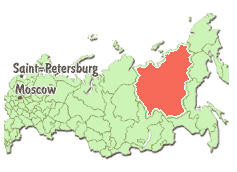
Yakut
Yakut (cаха тыла), also called Sakha, is a member of the Northern Turkic branch of the Altaic language family. Its closest relatives are Shor, Tuva and Dolgan. Yakut is spoken mainly in the Sakha Republic ( formerly Yakut Autonomous Republic) of the Russian Federation near the Arctic Ocean, in a sparsely populated area of 1.2 million square miles with 1 million inhabitants. It is also used by ethnic Yakut people in the Khabarovsk Region of Russia’s Far East, and by a small diaspora in other parts of the Russian Federation, Turkey, and in other parts of the world. The total number of speakers of Yakut is reported to be around 450,000 (Ethnologue).
Most scholars believe that the ancestors of modern Yakut were an ancient Turkic people who inhabited areas around Lake Baikal and Angara River. When they were driven out of their ancestral lands by Mongol invaders, they came to the territory of Yakutia around the 15th or 16th centuries, possibly in several waves.
Status
Yakut is the official language of the Sakha (Yakut) Republic along with Russian. Both languages are used as a medium of education in elementary and secondary schools, and in vocational and higher education, in paper and print media, literature and theater. Yakut is used as a lingua franca by some other minorities such as the Even, Evenki, and Yukaghir people. Most Yakuts are bilingual in Russian as well as in a number of neighboring Paleosiberian languages, such as Even, Evenki, and Yukaghir. A small percentage of Russian-speaking residents of the Sakha Republic are also proficient in Yakut.
Dialects
Yakut dialects are quite similar, so that speakers of different varieties can easily understand each other. There are two basic dialects groups:
- Central dialect which consists of Aldan, Eastern and Western Lena varieties
- Peripheral dialect which is comprised of northeastern and northwestern varieties
Structure
Sound system
The sound system of Yakut is fairly typical of Turkic languages. It is characterized by vowel harmony, a type of phonological process that places limitations on which vowels may be found near each other in a word. There are two kinds of vowels — front vowels, which are produced at the front of the mouth, e.g., /i/, /e/, and back vowels, produced at the back of the mouth, e.g., /u/, /o/. Native Yakut words can contain either only all front or all back vowels, and all suffixes must conform to the vowel of the syllable preceding them in the word. For example, a vowel at the beginning of a word can trigger assimilation of the rest of the vowels in that word.
Vowels
Yakut has 8 short and 8 long vowel phonemes, i.e., sounds that distinguish word meaning. There is a contrast between unrounded and rounded front and back vowels. The latter are produced with rounded protruding lips. Vowel length distinguishes word meaning. Long vowels are represented in the orthography by double letters. In addition, Yakut has four diphthongs.
| Central | ||||
|---|---|---|---|---|
|
Unrounded
|
Rounded
|
Unrounded
|
Rounded
|
|
| Close |
i, i:
|
y, y:
|
ɯ, ɯ:
|
u, u:
|
| Close-mid |
e, e:
|
ø, ø:
|
o, o:
|
|
| Open |
ɑ, ɑ:
|
- /i/ = ee in beet
- /e/ = e in bait
- /y/ = second vowel in statue
- /ø/ has no equivalent in English
- /ɯ/ has no equivalent in English
- /ɑ/ = a in spa
- /u/ = oo in boot
- /o/ = o in bow
Consonants
Yakut has a fairly simple consonant system. The consonants /f/, /ts/, /ʃ/ occur exclusively in Russian loanwords. There are few consonant clusters, except in Russian loanwords. Consonant clusters in loanwords are often broken up by an inserted vowel, e.g., Russian край ‘district’ becomes кыраай in Yakut.
| Uvular | ||||||||
|---|---|---|---|---|---|---|---|---|
| Stops | voiceless |
p
|
t
|
k
|
||||
| voiced |
b
|
d
|
g
|
|||||
| Fricatives | voiceless |
s
|
χ
|
h
|
||||
| voiced |
ʁ
|
|||||||
| Affricates | voiceless |
c
|
||||||
| voiced |
ɟ
|
|||||||
| Nasals |
m
|
n
|
ɲ
|
ŋ
|
||||
| Tap |
ɾ
|
|||||||
| Lateral |
l
|
|||||||
| Approximant | plain |
w
|
z | z |
j
|
z | z | |
| nasalized |
j̃
|
|||||||
- /c ,ɟ/ have no equivalents in English
- /χ, ʁ/ have no equivalents in English
- /ɲ/ = first n in canyon
- /ŋ/ = ng in song
- /j/ = y in yet
- /j̃ / has no equivalent in English
Stress
With a few exceptions, stress in Yakut words is normally placed on the final syllable. The placement of the original stress in loanwords is usually preserved.
Grammar
Like all Turkic languages, Yakut is agglutinative, i.e., grammatical relations are indicated by the addition of suffixes to stems. There is a one-to-one relationship between suffix and meaning, so suffixes are strung together one after another. There are various rules for their ordering. Like all Turkic languages, Yakut uses postpositions rather than prepositions to signal certain grammatical relationships.
- Yakut nouns are marked for number (singular and plural). Plural is marked by the suffix -lar (which has many variants), e.g., mas ‘tree’ and mastar ‘trees’.
- There are two declensions: singular and possessive.
- Possession is marked by suffixes.
- Yakut lacks the genitive and locative cases that exist in all other Turkic languages. The case system includes nominative, dative, accusative,instrumental, comitative, ablative, partitive, and two comparative cases. Cases are marked by inflectional suffixes and are governed by verbs and postpositions.
- A special class of auxiliary nouns is used to express spatial relations.
- There are several ways of expressing the direct object of verbs.
- There is no grammatical gender.
- There are no articles.
- 3rd person singular pronouns do not distinguish gender, e.g., uol refers to ‘he, she, it’.
- Personal pronouns are not declined.
Verbs
Verbs agree with their subjects in person and number. Verbs have the following grammatical categories:
- two numbers: singular and plural
- three persons: 1st, 2, 3rd
- three tenses: present, past, future
- There are several past tenses and several future tenses. .
- Evidentiality is required. Yakut distinguishes between information reported directly or one the speaker is sure of, and information reported indirectly or one that the speaker is not sure of.
- Aspect is expressed through auxiliary verbs or affixes.
- There are four moods: indicative, imperative, conditional, and subjunctive.
- Yakut distinguishes between active and passive voice.
- Modal and auxiliary verbs are widely used.
- Negation is formed by adding the particle –(y)ma to the verb stems , e.g., sanaa ‘think’ and sanaa-ma ‘not think’.
Word order
The normal word order in Yakut sentences is Subject-Object-Verb. However, other orders are possible, depending on discourse-oriented considerations such as emphasis. Adjectives precede the words they modify.
Vocabulary
The basic vocabulary of Yakut consists of words of Turkic origin plus a large number of borrowings from other languages such as Mongolian, Tungusic, Russian, and various languages spoken in Eastern Siberia and Russia’s Far East. Earlier borrowings came principally from Mongolian. It is estimated that about 30% of Yakut vocabulary consists of loanwords from Mongolian, e.g., дьыл from Mongolian жил ‘year’. Earlier borrowings from Russian underwent changes, e.g., самовар ‘samovar’ became сылабаар. Later borrowings from Russian mostly relate to science, technology, and modern life, e.g., kinige ‘book’, from Russian kniga.
Below are some common words and phrases in Yakut.
| Hello | эҕэрдэ |
| Good bye | көрсүөххэ диэри |
| Thank you | баһыыба |
| Please | баһаалыста |
| Yes | Ээх |
| No | суох |
| Water | уу |
| Sky | халлаан |
| Snow | хаар |
| Man, person | киһи |
Below are Yakut numerals 1-10. They are quite similar to numerals in other Turkic languages.
|
1
|
2
|
3
|
4
|
5
|
6
|
7
|
8
|
9
|
10
|
|---|---|---|---|---|---|---|---|---|---|
|
биир
|
икки
|
үс
|
түөрт
|
биэс
|
алта
|
сэттэ
|
аҕыс
|
тоҕус
|
уон
|
Writing
- The first Yakut text was published in Amsterdam in 1705.
- The first book in Yakut was published in 1819. It contained translations of religious texts and was written in an adapted version of the Russian alphabet developed by a Russian missionary. This early alphabet did not accurately represent the Yakut language and was abandoned.
- In 1851, a revised Yakut alphabet was developed by Otto Böhtlingk. It contained Russian letters with a few additional symbols to represent Yakut sounds not found in Russian. This orthography was used in the first Yakut dictionary as well as in Yakut folk tales published between 1907 and 1930.
- In 1917, a script based on the Latin alphabet was proposed by Semyon Novgorodov. In addition to the standard Latin letters, Novgorodov’s system included additional symbols. This system was used until 1938, when a new Cyrillic-based alphabet was developed and has been in use ever since. The alphabet consists of Russian letters one plus 5 additional letters: Ҕҕ, Ҥҥ, Өө, Һһ, Үү. Letters in parentheses are used only for writing Russian words.
|
A a
|
Б б
|
(В в)
|
Г г
|
Ҕ ҕ |
Д д
|
Дь дь
|
(E e)
|
(Ë ë)
|
Ж ж
|
З з
|
И и
|
Й й
|
К к
|
Л л
|
М м
|
|
Н н
|
Ҥ ҥ
|
Нь нь
|
О о
|
Ө ө
|
П п
|
Р р
|
С с
|
Һ һ
|
Т т
|
У у
|
Y ү
|
(Ф ф)
|
X x
|
Ц ц
|
Ч ч
|
|
(Ш ш)
|
(Щ щ)
|
(Ъ ъ)
|
Ы ы
|
(Ь ь) |
Э э
|
(Ю ю)
|
(Я я)
|
Take a look at these items from Yakut newspapers.
| Sports report Виктор Лебедев – Арассыыйа чөмпүйүөнэ! Красноярскай кыраай сүүмэрдэммит хамаандатын аатыттан киирсэр бөҕөспүт Виктор Лебедев 55 киилэҕэ көҥүл тустууга дойду сүрүн түһүлгэтин кыайыылааҕа буолла. |
| Weather forecast ыраас, сөҥүүтэ суох, салгын баттааһына 739..741 урт.ост.мм., тэмпэрэтиирэ 24..26°C, тыал – соҕурууттан, сөк. 1..3 м күүстээх, салгын сиигэ 28..33 % |
| Article about a rock musician Саха аныгы рок-муусукатын сэҥээрээччилэр балайда өр кэтэспиттэрэ туолла. Бэрт соторутааҕыта Эстрада тыйаатырын муусукаҕа салаатын салайар Евгений Тазетдинов устуудьуйатыгар «103» бөлөх «Бүтэһик пионер» диэн бастакы диискэтин таһаарда. |
Difficulty

There is no data on the difficulty of Yakut for speakers of English.